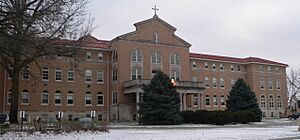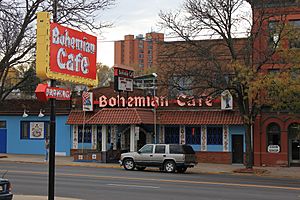Czechs in Omaha, Nebraska facts for kids
Czechs in Omaha, Nebraska have played a big part in shaping the city's history, culture, and community since the first Czech people arrived in 1868.
Contents
Why Czechs Came to Omaha
In the 1860s, many Czech people, mostly from areas called Bohemia and Moravia, moved to Nebraska. Two early newspaper editors in Omaha, Edward Rosewater and John Rosicky, were originally from Bohemia. They encouraged their fellow Czechs to come to Nebraska by talking about the promise of free land. By 1880, Czechs were the largest group of immigrants in Omaha.
Here's how the Czech population grew in Omaha:
| Czech population in Omaha | |
|---|---|
| Year | Number |
| 1880 | 900 |
| 1890 | 2,675 |
| 1930 | 3,964 |
In 1893, a famous Czech music writer named Antonín Dvořák visited Omaha. He even performed there, and people came from far away to hear him. His long visit to the United States inspired him to write his famous 9th Symphony: From The New World, also known as the New World Symphony. This music was inspired by his time in America, including bird songs, ragtime music by Scott Joplin, band music, and folk songs.
Groups called Komenský Clubs were started in Nebraska, including in Omaha and Lincoln. These clubs helped Czech immigrants. In 1914, when the Bohemian National Alliance was formed, its main office for the Midwest was in Omaha. Czechs in the city also helped support the idea of Bohemia becoming an independent country after World War I. This led to the creation of Czechoslovakia. By 1920, about 3,500 Czech immigrants lived in a part of Omaha known as Bohemian Town.
Famous Czechs from Omaha
Many Czechs from Omaha became well-known for their achievements.
Leaders and Writers
One of the most famous Czechs from Omaha was Roman Hruska. He was elected to the US Senate from Nebraska in the middle of the 1900s. He was very proud of his Czech background. Another important Czech from Omaha who worked in politics was Thomas Capek. He was a lawyer and a member of the Nebraska State Legislature in the early 1900s.
Edward Rosewater was a Czech immigrant who came to Omaha in 1863. In 1871, he started a newspaper called the Omaha Bee. In the same year, he also started the first Czech newspaper in Omaha, called Pokrok Západu, which means "Progress of the West."
Jan Rosický (1845-1910) was another important person. He started and published Západní Česko-Bratrská Jednota, or ZČBJ, which was a Czech-language newspaper. It was printed in Omaha and sent all over the U.S. and even back to Bohemia. Many people believe Rosický encouraged thousands of Czechs to move to the United States. There's a monument in his honor at the Czech National Cemetery in Omaha. It says:
- "To an unforgettable brother, Czech patriot, and leader of his people. Erected by the Western Bohemian Benevolent Association and grateful fellow countrymen. To live in hearts we leave behind is not to die."
His wife, Marie Rosická (1854-1912), wrote a cookbook that was published in both Czech and English many times. Their daughter, Růžena (Rose) Rosická (1875-1954), wrote a book in 1929 about the history of Czechs in Nebraska.
Dr. Vladimír Kučera (1906-1988) was a historian who wrote many books about Czechs in Nebraska. He wrote about their contributions to Nebraska's progress, Czech churches, drama, and music in the state. He worked for the Nebraska State Historical Society for 38 years.
Athletes
Some notable athletes from Omaha with Czech roots include Tom "Train Wreck" Novak, a great football player at the University of Nebraska. Also, The Dusek Family were famous in the early days of professional wrestling.
Czech Legacy in Omaha

Czech people from Omaha helped get approval to start a Czech Language Program at the University of Nebraska at Lincoln in 1907. Also, a course about Czech heritage was created at the College of St. Mary in Omaha. These programs have been important places for teaching Czech language, literature, and culture for a long time.
Nuns of Czech background raised money to build and staff the Notre Dame Academy and Convent at 3501 State Street. This place helped the Czech community in the area. Czech immigrants and their families also started the Sokol South Omaha Czechoslovak Museum at 2021 U Street in South Omaha. They also founded the Bohemian National Cemetery at 5201 Center Street. Other cemeteries with many Czech burials include Calvary Cemetery, Holy Sepulchar Cemetery, and Saint Mary Catholic Cemetery.
Little Bohemia Neighborhood

A very important Czech landmark in Omaha was a special neighborhood called Little Bohemia. It was a busy area with shops and businesses, mainly along South 13th and South 14th Streets, and William Street. Little Bohemia was bordered by South 10th Street to the east, South 16th Street to the west, Pierce Street to the north, and Martha Street to the south. This neighborhood included important places like the Prague Hotel, Sokol Auditorium, and Bohemian Cafe, which were all key parts of the community.
Another important neighborhood for Czechs was located around Brown Park.

